Blog 10:

When I originally started this class, I was scared the workload would be too intense; however, I found if I spaced out my readings, blog entries, and papers throughout the week, then by the day everything was due, I wouldn’t be overwhelmed with everything. I don’t think my expectations have changed much. The class was as reading-intensive as I thought it was going to be.
I think this class not only taught me about social psychology, but it taught me how to manage my time. Time management is still something I’m working on. I think learning time management is something that’ll help me not only in my academic life but also in my professional life. Previously, I used to spend a lot of time procrastinating. While I’d always get my work done, in the end, I always felt extremely stressed out because I’d waited till the last minute to finish everything.
Another thing I learned from social psychology that I can use in my professional life is impression management. I found the artifact to archive very helpful for that chapter. Previously, I’d never thought about preparing myself for interviews. In the weeks or days leading up to the interview, I’d simply worry over it. Now I can do something productive with my worry like plan what I’ll wear, and practice interview questions.
I don’t think my attitude about social psychology has changed much. I always thought it was would an interesting and useful subject to learn. I will say that I didn’t realize everything social psychology would cover. I also didn’t realize how much overlap the class would have with my communication class. I found it helpful that the two courses went hand-in-hand because they helped me understand the concepts better. The only downside is the two classes didn’t always use the same terms for the concepts, which could be confusing sometimes.
If I took the class again, I think I would like to take it in person so that I could listen to a lecture. That is something I miss about going to class in person.
I chose the image above because I was surprised by how much this social psychology class covered the workplace. It really helped me think of ways that I could improve myself not only personally, but professionally as well.
Blog 9:

I’ve learned several things in this Social Psychology course. First, I learned about how heuristics help guide us in making decisions. It was interesting to see how the lesson on social heuristics expanded on the information from my Introduction to Communication Class. I think it’s important to know why we make a decision and what has influenced us to do so. The social heuristics chapter goes hand-in-hand with the fifth blog. The fifth blog asked us to examine advertisements and note whether they were credible or not. Most companies buy air time or spots in papers to continually expose us to their products. Through this classical conditioning technique, they can trigger our availability heuristic. When we think of the product, our minds jump to that company’s product because we can easily recall exposure to the stimuli (the advertisement).
Another thing I learned about was self-efficacy. I think it’s a crucial trait to develop. I think the idea of self-efficacy from blog post two connects with assignment takeaway four. Assignment takeaway four talks about different styles of love. I feel stable, healthy relationships with loved ones can help lay the foundation for self-confidence and self-efficacy.
I also think the self-efficacy blog post and the emotional intelligence blog post connect. Your ability to understand your own emotions and self-regulate plays a hand in your self-efficacy. I’ve found, personally, that the less I’m able to self-regulate, the less I’m able to believe that I can accomplish things. I would drown in those feelings of helplessness in the past and didn’t know how to get myself out.
I also learned why people are racist or discriminate against others. Assignment takeaway three and top artifact two are connected. Top artifact two asked us to examine stereotypes of different groups of people and then explore our own group’s stereotypes. Assignment takeaway three asked us what we learned when analyzing Michael Richards’ tirade against a Black heckler. It’s essential to examine our prejudices and ask why we have them.
We learned about impression management in class, which was very helpful in Introduction to Communication. In my Introduction to Communication class, we talked about public speaking. When you’re engaged in public speaking, you also have to manage the impression you’re making on your audience. Understanding impression management also helped me successfully interview for a research lab opportunity at ODU. It made me think of how I’d dress, speak, and interact with the professor interviewing me.
In conclusion, I think that most of the concepts in this class are not only applicable but intertwined with each other. That is why I chose a web for the visual for this entry. After you understand the core concepts, you’re able to branch out and build on what you’ve already learned.
Blog 8:

This article suggests that the sexes have different evolutionary sexual needs, and these needs cause sexual conflict within relationships. It plays on the old idea that “men are from Mars and women are from Venus.”
When I was a freshman in college, I took an Introduction to Psychology course. The professor spoke about how, possibly, men were evolutionarily polyamorous and women monogamous because of how human fertility works. He explained that some believe because men can continue reproducing until death and women cannot, men are hardwired to want to “spread their seed,” so to speak. The professor then said that possibly, that’s why so many men cheat on their wives.
The concept is interesting, but I’ve never researched it.
Possibly there is sexual conflict based on evolution. Or possibly there is conflict because of our societal views of the sexes.
This article mentions that men “pair widely” and women “pair wisely” because men have a “lower obligatory parental investment” than women. Perhaps this rings true. Are women more obligated to parenthood based solely on their biology? Are women more invested in parenting because they carry their children to term while men do not? Or were women socialized to feel that way?
It’s hard to say. I’m hardly an expert on the subject. I’d have to read more studies about it.
The article then asks how men and women upset each other, creating sexual conflict, and how might evolutionary psychology play a role?
Men tend to get upset with women because they’re “too emotional.” But unfortunately, they often don’t know how to handle women’s emotions. Men may also become angry when women don’t say what they need. Is this because they’re socialized to fix things and become frustrated when there aren’t any clear actions to take, or because hormones like testosterone that play a role in anger and aggression?
Women tend to get angry with men when they’re dishonest. For example, many women want relationships, and men express they also want relationships, but they just want sex. I think women would be less likely to be upset with men if they were honest about their intentions.
In the communication course I’m taking, we’ve touched on how men and women are different in communication styles and socialization. For example, men tend to be action-oriented, and women tend to be emotion-oriented. It seems as though conflict may arise because of these differences.
I think there’s a line between evolutionary differences and how the sexes are socialized. But unfortunately, I don’t know exactly where that line is.
I chose the above image because it shows infidelity, which is something that many men may engage in that makes women angry.
Blog 7:
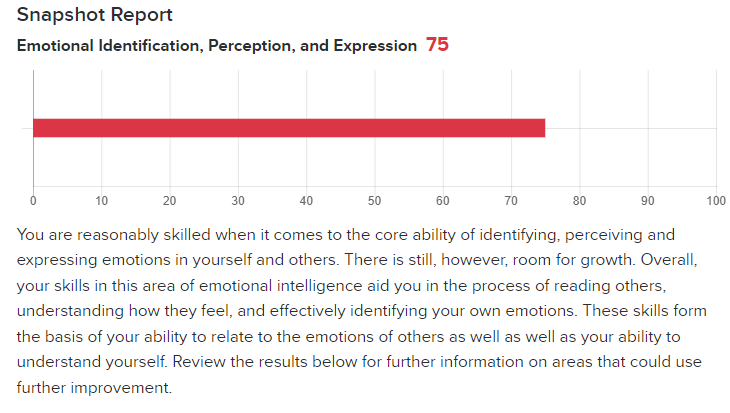
For a long time, I believed emotional intelligence dealt only with the emotions of others. I thought that it was being able to understand and empathize with others. I didn’t really understand until much later that emotional intelligence also entailed understanding and analyzing your own emotions.
When I was much younger, I wasn’t very good at self-regulating. I would hyper-fixate on my negative emotions. Sometimes I still do that, but I’ve learned throughout the years that hyper-fixating won’t make things better or change anything.
Not too long ago, I had a friend who had started speaking less and less to me. At first, I was fixated on my negative emotions about it. I felt like maybe they didn’t like me anymore, or I’d done something to make them angry because they weren’t messaging me back. Once I started thinking about it though, I realized that these were just knee-jerk reactions. I couldn’t remember a moment in the recent past where I’d said or done anything upsetting. After I got up enough courage, I messaged my friend to ask if she was okay. It turns out that she’d been having a rough emotional time, and that she never meant to avoid me. I think that I still need to work on my emotional intelligence and my negative thought patterns. I shouldn’t have projected my feelings onto the situation because I fed myself an obviously fake narrative that didn’t help the situation.
I think my emotional intelligence is much better than it used to be. I think it’s an ever-evolving process. My current husband is extremely supportive and very even-keeled. He makes me feel safe when I disclose my feelings or thoughts. It’s really helped me cultivate my self-regulatory skills and self-efficacy. It’s also helped me be able to voice my needs in my other types of relationships.
I chose the image above because it shows the score I received on the emotional intelligence test.
Blog 6:
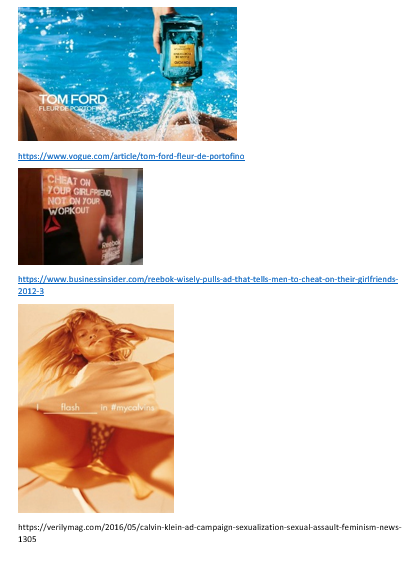
I was not surprised by Jean Kilbourne’s ted talk on The Dangerous Ways Ads See Women. Before watching this ted talk, I knew that many ads sexualized women to sell products; however, I felt unnerved by how pornographic those ads have become. For example, Jean Kilbourne shows an advertisement for a cologne. You can only see this woman’s torso in this advertisement, and the cologne bottle covers her genitals. On my search for sexualized ads, I found that Tom Ford advertisements use sex to sell everything from men’s clothes to cologne. In addition, I found an ad in Vogue that shows only the buttocks of a woman being showered in cologne. The woman doesn’t have a face, which completely dehumanizes her.
The following picture I found was an advertisement from Reebok. While this advertisement doesn’t sexualize women like the previous one, it harbors ill attitudes toward women. For example, the slogan says, “cheat on your girlfriend, not your workout.” Statements like this make it evident that women and men’s relationships with women aren’t important.
This next advertisement is from Calvin Klein. In it, The camera shot looks up the young woman’s dress, and the slogan states, “I flash in #mycalvins.” This advertisement encourages harmful behavior. Not normalizes upskirting and peeping tom behavior. Also, the girl in this advertisement looks to be very young.
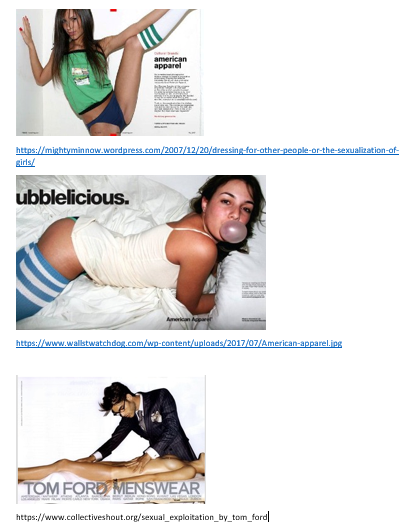
This American Apparel advertisement shows a young girl in her underwear in a sexualized, submissive pose. Unfortunately, many ads show young women in hypersexualized, submissive poses. American Apparel is a store where many teenagers shop. The following advertisement is also an American Apparel ad. It also shows this young woman in a submissive pose, lying down. She’s chewing bubble gum, which makes her seem extremely youthful — childlike. Advertisements like this normalize the sexualization of young girls.
The last one is another Tom Ford advertisement for men’s wear. In it, we see the torso of a young woman being touched by a man who is fully dressed. Again, this advertisement dehumanizes the woman by never showing her face and makes it seem like women are just men’s playthings. She is depicted as submissive.
If there are men in these types of advertisements, they’re almost always in a position of power. They are positioned above women or standing. They’re often (but not always) fully clothed when the women aren’t.
I agree with Jean Kilbourne that these advertisements are detrimental to women and men’s perceptions of women.
All of the images and adds were chosen because they show the violence, dehumanization, and sexualization of women in ads.
Blog 5:

To the left, there is an advertisement for the toothpaste Sensodyne. This is a credible advertisement because it shows a dentist recommending the product. People are more likely to believe and trust an expert. Advertisements using experts to sell a product give us the comfort that we are making the right choices.
Even if there isn’t a dentist in the advertisement, most toothpaste commercials include the survey “four out of five dentists recommend…” to make you trust their product.
To the right is a screenshot from a Dove advertisement. If you watch the clip, you will see a black woman taking off her shirt, turning into a white woman. This is an unreliable advertisement. It’s important to understand the impacts that advertisements like this have. In essence, Dove, whether intentionally or not, is implying that white is beautiful. This can hurt those in minorities who are not white, fostering a sense of low self-esteem. Dove has since apologized for this advertisement. They now advertise “be comfortable in your skin.” While that particular campaign does showcase diverse people, it does not showcase diverse body types. Dove lost a lot of credibility and trust in their product with this particular advertisement.

Dove Advertisement – https://www.washingtonpost.com/news/business/wp/2017/10/08/dove-ad-that-shows-a-black-woman-turning-herself-white-sparks-consumer-backlash/

The picture to the left shows an advertisement for Neutrogena. Neutrogena is known to use beautiful, famous women as their spokespeople. The company also chooses these women as they are popular at the time and have a good reputation. The public likes these women. They are able to sell their products because the person in the advertisement is pretty (and we also want to be pretty) and they are someone we can easily identify.
I think, in regards to Neutrogena and products like it, an attractive communicator is effective for their advertisement because they know exactly who their target audience is. They know which women the public adores and respects.
I chose each image because they show each category of advertising that we were asked to identify.
Blog 4:

The first test is in the books, and it was a welcomed challenge! The questions forced you to think critically about the vocabulary and concepts instead of regurgitating the text. The only other time I’ve had a test with similar questions was when I became an EMT.
I did well on the test, but there’s always room for improvement. I missed three questions. Since reviewing those incorrect answers, I’ve found I didn’t read through the questions and choices carefully. I think this is because I felt anxious about the timer. Since taking the test, I now know that the time allotted is more than enough. Next time, I’ll concentrate better on the test questions.
For the test review, I used a variety of study materials. I used my notes, the study guide, the jeopardy videos, and the text. When writing my notes, I made sure to include the information from the PowerPoint in the module. I also made sure to read my notes a couple of times a week to keep the concepts fresh in my mind. The text has an audiobook feature that I found very useful. As I worked at my job, I listened to the text to expose myself to the material in different ways to maximize my learning experience.
I found my study strategy effective for me. I will continue to review all the sources available to me.
The above image was chosen because I felt that the jeopardy videos Prof. Muth recorded have really helped me study.
Blog 3:
Dr. Selterman proposes a fascinating look at the link between music preferences and relationships in his essay “Soul Meets Body.” I always thought that music gave you a glimpse into someone’s soul. When people ask you to listen to a meaningful song, I believe they show you a very intimate part of themselves. While I’ve never thought about the idea that there’s a link between music preferences and relationships, I can’t say I’m surprised. Many of my friends (and even my husband) have music tastes that overlap with my own. Music is extremely important to me, and it’s also extremely important to my husband. We spent much of our first date talking about music and the instruments we play. My husband and I enjoy rock music, but his tastes lean more toward rock music that draws heavy inspiration from classical music. My husband is a very talented pianist, so it doesn’t surprise me that he would gravitate toward music with classical instruments in it. I would say that my husband and I have similar values, but I would also say that some of my husband’s values are a little more conservative than my own.
The image I chose was that of the playlist on Spotify to give people a visual of what each of the album covers look like. The playlist below consists of songs that remind me of people who’ve impacted my life. The impacts were both positive and negative.

1.) I am the Fire – Halestorm -This song represents my life.
2.)Stand By Me – Ben E. King – For my husband. One of the most stable people in my life.
3.) Connect – Sick Puppies – For my Dad. His split from my mother was hard on our relationship. As an adult, I’m trying to reconnect with him to repair a relationship that was damaged by the lies of others.
4.) What’s up?-4NonBlondes – For my mother. She has since passed. One of my favourite memories was sing-screaming this song as a kid with her. It was one of her favourite songs. Reflecting on this as an adult, I can see why she identified with it as she fought with bipolar disorder most of her life.
5.)Tornado – Little Big Town – For my Ex husband – My ex-husband was terrible to me, but taught me a lot about what I will and will not put up with. This song reminds me of how I felt when I left and filed for divorce after years of mistreatment.
6.) Home – Michael Buble – For my Paternal Grandmother – When my mother passed, she became the person I most associated with home. She is the person who believed I could do anything.
7.) Painting the Sun – David Lanz – For My Husband (again) – This song is so special to me because it’s one of the songs my husband plays on the piano for me.
Blog 2:
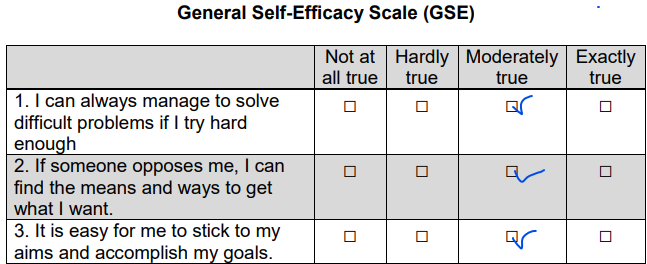
In summer 2021, I returned to Old Dominion University after a long separation. It had been thirteen years since I’d done anything academically, and I was extremely nervous about returning to school. It was a new beginning. I changed my major from English to Psychology. I decided to go back to school while also working full time. I was riddled with anxiety because I didn’t know if I could do this. Could I keep up with classes and maintain a professional and personal life?
My confidence as a student was almost nonexistent in the summer of 2021. I didn’t tell anyone except my husband that I had signed up for two classes. I didn’t want to disappoint anyone if I decided to withdraw. I was nervous about due dates and assignments and keeping up with readings. At the time, I felt extremely overwhelmed with classes because I felt like I didn’t know what I was doing.
I was persistent, though. I read the directions of each assignment carefully to make sure I understood what the professor was asking of me. If I didn’t understand, I asked clarifying questions. I turned in assignments well before they were due.
My anxieties eased as professors sent me positive feedback. My confidence grew as I received good grades. I was proud of myself when I received A’s for my final grades. While I am still not completely confident in my abilities, I believe as I continue to do well in the tasks I set out to do, that confidence will continue growing. I also believe having a good support system will also help me to achieve my goals and gain confidence.
I think I’m a good student who seeks to learn from each assignment I do. I tend to do more than the bare minimum and take the time to absorb the information. I usually avoid procrastinating. I try to finish my readings and assignments before they’re due in the event that I have to attend to any personal or professional responsibilities.
I think my self-efficacy scale shows my growing confidence as a student. I scored a 31 with a mean of 3.1. Most of my answers were “Moderately true” except the answer for the statement: “I can solve most problems if I invest the necessary effort.” For that statement, I chose “Exactly true.” If you’re willing to put forward the necessary time, energy, and effort, you can find resolutions to most problems. I think as my confidence grows, the answers to this self-efficacy scale will change.
I look forward to continuing my academic journey. I’m excited to see how my confidence will grow and how that may change me as an academic, professional, and person.
Blog 1:
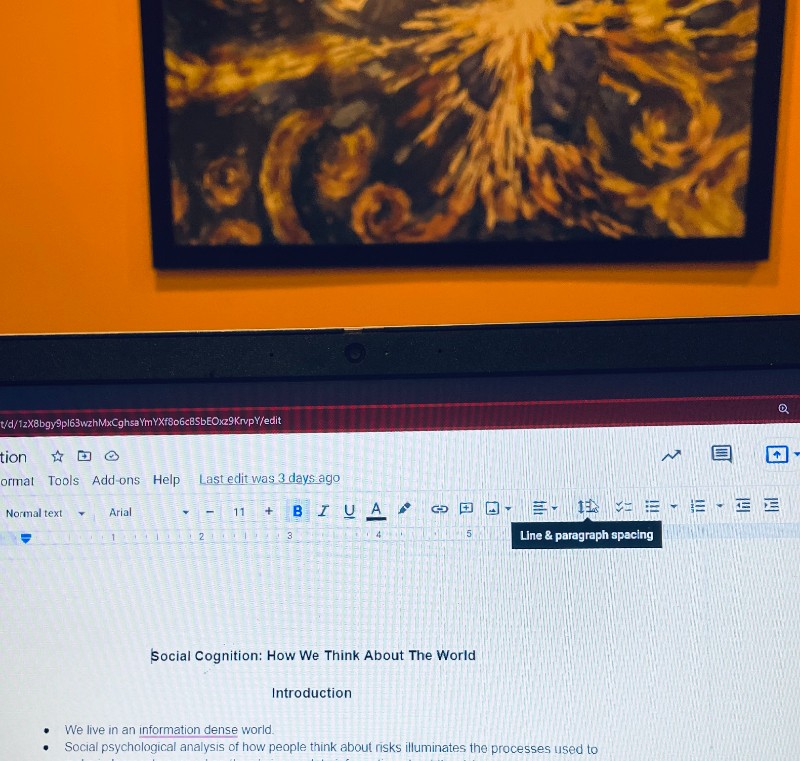
Snapshot of Chapter 2’s notes. I chose this picture because taking notes is an effective way for me to learn the material. It allows me to put the book’s concepts into my own words.
Every class is like mining for gold. You chip away sediment until you discover a nugget of use and interest. However, mining social psychology is like striking a gold vein. Social psychology is fascinating but also applicable and easily integrated into daily life.
Understanding social psychology is advantageous because it helps us understand people’s behavior and what factors may affect social behavior. It also allows us to examine how we may perceive and interpret those behaviors. Social psychology will also allow us to understand how attitude and behavior entwine. It allows us to understand how discrimination affects the behaviors of different groups of people. Also, social psychology gives us insight into why we like people and how those factors help us form relationships.
Moving forward, I can use the things I learn in social psychology outside of my academic life. For instance, exploring my perception and interpretation of social behavior will allow me to understand and examine my own knee-jerk, emotional reactions to other people’s behavior. I know in the past, I’ve assumed or thought people felt a certain way because of their behavior, even though those people never told me their feelings. I can utilize what I learn in social psychology to think more logically and remind myself that it’s impossible to know what people are thinking or feeling unless they tell me.
I hope to gain insight into why people do the things they do. Often, people leave me confused. I hope learning social psychology will allow me to understand other people’s behavior. I’d like to gain insight into my own behaviors and what affects them.
I expect this class to be very reading-intensive. I’ve prepared myself for the workload by dividing it equally over the week. I do a little bit of work each day to stay on track with the schedule. I’ve adopted a planner with all my due dates. I try to begin my writing assignments well before they’re due. Based on the jeopardy questions Prof. Muth has recorded, I expect many of the questions on the exams will be less about the definition of the terms, but how to apply those concepts to real life. To make sure I understand the term, I often talk to my husband about the information I’m learning in the course. I also utilize the flashcards in the book. Hopefully, these strategies will help me be successful in this social psychology course.
I look forward to a semester filled with fascinating information that I can apply to my social, academic, and professional life.